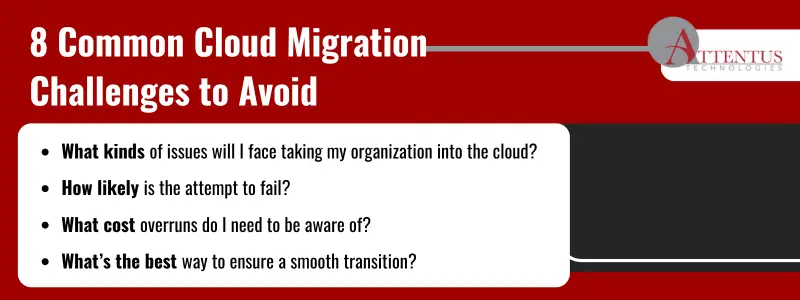While taking your company to the cloud may be a great business decision, it can be a process fraught with problems. Here’s what you should avoid to keep the transition smooth

Adoption of the cloud is increasing exponentially. Statistics show that 60% of corporate data is now stored in the cloud, doubling the amount from 2015. The cloud computing market, valued at $545.8 billion, is projected to grow to $1.24 trillion by 2027.
There are good reasons for the rapid uptake of cloud computing, including the fact that data stored this way is much easier to access and generally more secure than with simple in-house networks.
Even so, the migration to the cloud isn’t always smooth. Approximately one-third of transitions to the cloud fail outright, and only one in four organizations meet their migration deadlines.
“The cloud is a hot topic,” says Charles Bender, Chief Executive Officer of Attentus Technologies. “That’s making a lot of people rush in without thinking about it first. That’s a mistake. Instead, you need to take the time to plan it out right to avoid trouble down the line.”
You definitely don’t want your organization to lose time and money with a failed cloud migration. Here are eight common cloud migration challenges to keep in mind so your process can be smooth and successful instead of fraught with issues.
1. Service interruptions
Transitioning to cloud-based systems can temporarily reduce network performance due to increased data migration traffic. It’s important to note that these slowdowns pose risks to productivity and customer satisfaction.
To address this issue, try migrating in stages. Don’t lift and shift all your data in one go. Instead, break your data into segments and prioritize which ones to move first. You may also want to consider performing migrations outside peak working hours.
2. Cost overruns
Cloud computing can be highly cost-effective, reducing the costs of buying hardware and software, eliminating upgrade and maintenance costs, and other reasons. While you may enjoy these savings in the long term, you risk unexpected cost overruns during a migration.
With various services, data transfer fees, and scalability options, budgets can quickly become stressed if not appropriately monitored. Failing to right-size your cloud resources or not turning off unused services can also lead to unnecessary expenses.
Planning is the solution to overruns. Prepare for the unexpected, and consider your needs before you start. Put aside a small amount of your cloud budget to deal with this potential issue. It’s always best to have an extra backup budget and not use it.
3. Incompatible applications
Compatibility challenges arise when applications originally designed for on-premises legacy systems don’t align with the new cloud environment. Differences in platform requirements, software dependencies, or outdated application code are the usual culprits.
Before migrating, assess your applications for cloud compatibility. Update any outdated software, and consider retiring applications that aren’t cloud-ready and replacing them with ones that are. If necessary, seek expertise in cloud-native development to redesign or adapt your applications.
4. Data synchronization
A delay in updating data from the source to the cloud can cause synchronization problems. Since source information can change at any time, such as when an employee updates their address, this may result in discrepancies and complicate maintaining data integrity and accuracy during migration.
To avoid this, schedule regular sync intervals, even during migration, as part of your cloud migration strategy. Factor these updates into your overall cloud migration schedule. Continue this practice if you intend to take a hybrid cloud approach.
It’s also a good idea to have a robust data backup and recovery plan, either in the cloud or on-site.
5. Security Breaches
Data is particularly at risk during transit. Cybercriminals can hijack the transmission stream, stealing sensitive personal and corporate information as it flows from source to destination.
You can protect yourself from this abuse by using proper encryption methods. Encrypted data can’t be read unless you have the right encryption key. Surprisingly, the majority of companies don’t take the important precaution of encrypting data.
Other cloud security threats that you need to protect yourself from in a cloud-computing environment can include:
- Misconfiguration
- Denial-of-service attacks
- Unauthorized access to a computer network
- Insecure interfaces or APIs
- Hijacking of accounts
- External data sharing
- Malicious insiders
- Cyberattackers
6. Scope creep
Scope creep often sneaks in when there are no clear project boundaries, inadequate communication among stakeholders, or new requirements introduced mid-migration. Adding “just one more feature” or making “one small change” is tempting, but these can accumulate and derail your cloud migration project.
Establish a clear, detailed migration plan to avoid such common cloud migration challenges. Ensure all stakeholders agree on the project’s scope, objectives, and deliverables at the start so there are no sudden surprises. Any later unplanned changes to the cloud project should undergo a rigorous evaluation process that considers the impact on time, cost, and resources before they get the OK.
7. Lack of resources
Not everyone has enough in-house experts to run a successful cloud migration. Some companies may have an adequate number but may bite off more than they can chew if upper management underestimates a project’s complexity.
Such situations can be avoided with the right managed cloud partner. You can get the expertise you need or add extra hands for your team to make moving to the cloud easier for everyone. Better yet, many partners are willing to stick with you post-migration. This helps keep your cloud infrastructure in top shape for a long time to come.
8. Performance issues
Moving to the cloud promises enhanced performance and scalability. However, suboptimal cloud configurations, network latency, or even choosing a cloud service that doesn’t align with your demands can undermine that promise post-migration.
Make sure everything is well configured before you launch. It’s much easier to fix things before going live than after. Once your cloud system is up and running, you should regularly monitor and adjust configurations to match your changing workload demands. The cloud is scalable, but you need to keep checking to ensure it operates as required as your business grows.
Let our experts help you to achieve a smooth cloud migration
To help you avoid common cloud migration challenges, consider consulting cloud data experts from Attentus Technologies. Our team has over 20 years of experience helping companies manage cloud projects like yours.
You can also count on us for:
It definitely won’t be a mistake to get in touch with us today for a free consultation and technology assessment.
